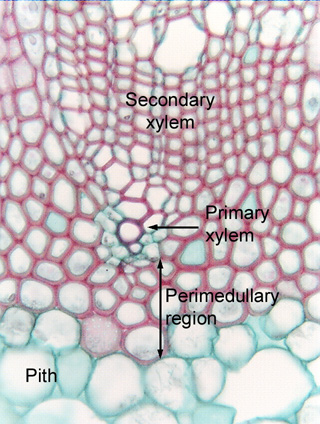 Fig.
11.4-1.
Transverse section of ivy stem (Hedera helix). In almost all stems, the
pith is a rather uniform mass of parenchyma. But in a few species, as this ivy
here, the outermost region follows a distinct developmental pathway, in this
case the cells differentiate as fibers, not as parenchyma cells. Whenever the outermost regions of pith are
distinctly different from the rest, they are known as a perimedullary region.
This is analogous to the cortex: whenever its outermost regions are distinct,
they are called hypodermis. But keep in mind, the perimedullary region – no
matter how distinct – is still considered to be a part of the pith, just as
hypodermis is part of the cortex.
Fig.
11.4-1.
Transverse section of ivy stem (Hedera helix). In almost all stems, the
pith is a rather uniform mass of parenchyma. But in a few species, as this ivy
here, the outermost region follows a distinct developmental pathway, in this
case the cells differentiate as fibers, not as parenchyma cells. Whenever the outermost regions of pith are
distinctly different from the rest, they are known as a perimedullary region.
This is analogous to the cortex: whenever its outermost regions are distinct,
they are called hypodermis. But keep in mind, the perimedullary region – no
matter how distinct – is still considered to be a part of the pith, just as
hypodermis is part of the cortex.